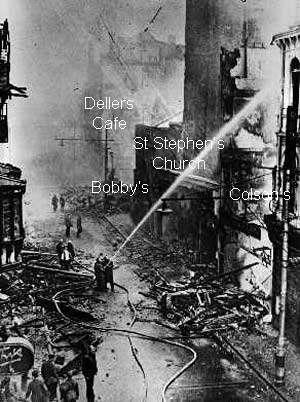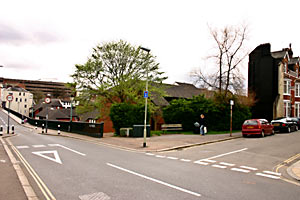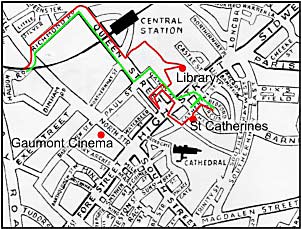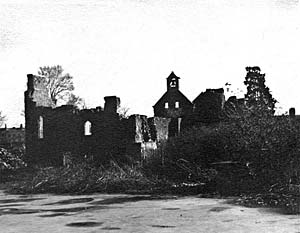
Exeter Stories
Exeter folk and friends in their own words - 1890's to the 1990's │ << Previous story │ Next story >> │
Link to Exeter blitz
James Bell - The Exeter Blitz
Friday 24th April 1942
"I was sheltering in the basement of 40 Haldon Road, with my parents, two sisters, and three brothers. There was a raid on, bombs were falling, guns were blasting away 'bang...... bang......', Glass was breaking, and ceilings, and chimneys falling. The noise was deafening - then we heard a string of bombs fall that was close, now closer, oh God this one must be for us. Fathers voice was praying through the racket - 'Lord we place our selves into your safe keeping. Lord Jesus save us'."
"We heard the bomb fall, it just went thud, there was no explosion. We never found where it fell. In the shelter, was this sign:
'God is our refuge
Don't be afraid
He will be with you
All through the raid
When bombs are falling
And danger is near
He will be with you
Till the all clear.'
"The next night was a Saturday. Lord Haw Haw had said that Exeter would be destroyed in three nights. We had two bad consecutive night raids and along with many Exeter residents we went out to Stoke Woods and spent the night there. The Mayor sent a hand bill, delivered to every door asking for all able body men to stay behind to fight the expected fires, this exacerbated the situation, it would have been better had he not sent it."
"The raid did take place but it missed the town, hundreds of incendiaries landing on Exminster marshes. This has not received much publicity. Many of the Exeter Corporation Buses which were moved to Marsh Barton and roads near Alphington for safety were burnt out."
Monday 4th May 1942 - the blitz
"My father was home on the night of the 3rd May 1942, he did fire watch duty on Thursdays only. At 3:30 am on the morning of the 4th of May, father left the house 40 Haldon Road and went as far as the entrance of St Davids Hill. He came back and said he would take the boys to see the fires. He said this was the most important happening in the history of Exeter for hundreds of years. What we would see would stay with us for the rest of our lives."
"My brother and I, with much protests from mother, went with Dad - it was 4 am - to the end of Haldon Road, down under the Ironbridge at Lower North Street. There was a fire, on the corner of Dinham Road with rubble in the road. The fire was from Dinham Road corner to as far as where the Bridge started. It was caused some said by an oil bomb."
"There were very few people about. We walked up North Street.as far as Waterbeer Street. We could see South Street ablaze, just one wall of fire with the flames joined together from both sides of the street. There were then some loud bangs from the area of the fire and the sky above Brocks became illuminated. The heat began to reach us, as we moved back as far as the entrance of the Gaumont Cinema. We stayed for about five minutes and then went home, we saw no one in North Street at that time."
Exploring solo
"At 11:30 am I went up Richmond Road into Queen Street and up into Northernhay through the wall into Rougemont Gardens (Northernhay Park and Gardens), I was looking for incendiary bomb fins, much prized by school boys!"
"I went inside the library and up the stairs, it was well alight. I had got in the staff entrance in Rougemont Gardens - outside there were exhausted fireman lying on the grass with there pumps still pumping water from the static water pond. I walked ankle deep through water and then up the stairs. The library staff came in while I was there to collect there personal effects - they did not take any notice of me!"
"I then went out of Rougemont into New Buildings Passage - I could not go along the path which skirted the gardens and led into Castle Street as there were fires burning. It was in the area of the High Street swimming baths. Leaving New Buildings I went into Gandy Street, and down Little Queen Street, looking up Queen Street, there was a fire on the roof of Cogswell & Harrison and the top of Queen Street was closed below Boots corner. With a rope across the road and two men standing on guard."
"I went back to Gandy Street and entered the High Street by Timothy Whites. Colsons, and Bobby's were on fire, almost burnt out. I crossed the road by Martins Bank and went down Martins Lane, where Wynne Tighe Chemists was on fire. I then went up Catherine Street, over the rubble and pools of water at the back of Colsons."
"I remember going into the Chapel, in Catherine Street at 12 noon on the 5th May 1942, walking around and sitting in the pews, There was no sign of the fire which eventually destroyed it - the building next to it was on fire. I was only ten years old! It always raises a wry smile when I read the inscription in the ruins of the St Catherine's Chapel - 'Destroyed by Enemy Action - May 1942'."
"From St Catherines I walked into Bedford Circus on the left hand side, and saw a hole in the side of an air raid shelter which was made by a unexploded bomb, in which one man was killed. A man started shouting at me, and told me to go back as there was a bomb here."
"When I went back to Catherine Street. I was again told I could not go that way. So I tried to go back by way of the High Street - I was again stopped. When I told the man I was trapped he let me through and I walked back over rubble, turning down into Gandy Street by Lyons Cafe, and went home to tell them all my adventures."
"So many places could have been saved, given the right organisation. They manage to save the Co-op building, with numbers of fire watchers throwing the incendiaries off the flat roof, and it was thought at the time that these incendiaries, ended up on the arcade roof, (Eastgate Arcade) and help to destroy it."
The Anecdote of the Rats
"There was a story going around at the time of the blitz, about a policeman, who was walking along New North Road and passing the Locomotive Inn towards London Inn Square. It being two hours before the fires started, he was confronted with thousands of rats coming down from the High Street, London Inn Square, and Sidwell Street. He stood with his back to the wall while the bulk of them ran past, into Northernhay Path, and Central Station. This did not receive much publicity at the time as there were more important things to report."
© 2005 James Bell/David Cornforth
James Bell - was born in Exeter in 1932, to a Plymouth Brethren family, and was one of twelve children. This article is an edited selection from a series of emails I received relating his memories of Exeter during the Second World War.
 Firefighters at Colsons in May 1942
Firefighters at Colsons in May 1942
Chief Fire Officers Report 4th May 1942
"0410 Timber Stores, Dinham Road, serious fire, tank No. 162 (cap. 15,000 gallons) adjacent to fire ground. Supplies supplemented from 'Header' on pipe-line No. 1. Relay of two lines 21/2" via Engine Bridge, North Street junction of Bartholomew Street. Shortage of pumps was severely taxing pipe-lines".
 The gap at the end of the terrace on the corner of Dinham Road was caused by the 'oil bomb', as described by James. Note the exposed gable end of the last house and the Ironbridge, left.
The gap at the end of the terrace on the corner of Dinham Road was caused by the 'oil bomb', as described by James. Note the exposed gable end of the last house and the Ironbridge, left.
 The red line is James route to Bedford Circus and the green, his return home
The red line is James route to Bedford Circus and the green, his return home The ruins of St Catherines Chapel where the young James sat for a few minutes
Photo Maurice Swansborough 1949
The ruins of St Catherines Chapel where the young James sat for a few minutes
Photo Maurice Swansborough 1949
│ Top of Page │